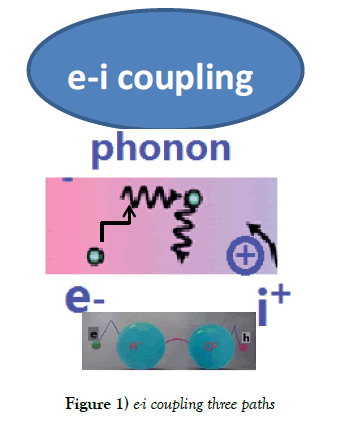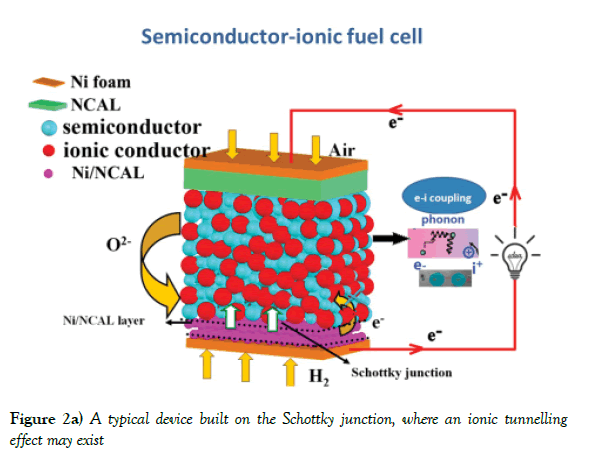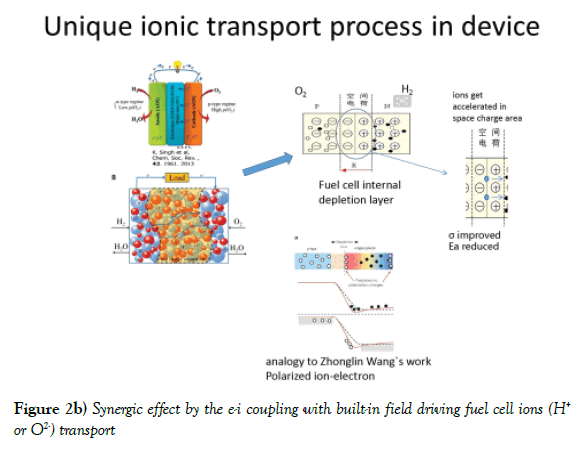Nano energy: Semiconductor-ionics (semionics) and new generation fuel cells
Received: 13-Sep-2017 Accepted Date: Sep 18, 2017; Published: 25-Sep-2017
Citation: Afzal M. Nano Energy: Semiconductor-ionics (Semionics) and new generation fuel cells. J Mod Appl Phys. 2017;1(1): 17-18.
This open-access article is distributed under the terms of the Creative Commons Attribution Non-Commercial License (CC BY-NC) (http://creativecommons.org/licenses/by-nc/4.0/), which permits reuse, distribution and reproduction of the article, provided that the original work is properly cited and the reuse is restricted to noncommercial purposes. For commercial reuse, contact reprints@pulsus.com
The research is related to studies of both materials and device processes for next generation fuel cell designs, developments and applications. In the Semionics based on novel functional semiconductor-ionic materials research strategy, the core is electron (e) and ion (i) coupling (EIC) effect as shown in Figure 1.
This can make at the material level: strong ionic conductivity enhancement and significant reduced migration activation energy while at the device level: can show significant enhancement in the power output because of no anode/ electrolyte and cathode /electrolyte interfaces present in the structure, it allows direct charge transfer through energy bands alignment and junction built-in field can drive the ion transport, i.e. synergic and tunnelling effects, see Figure 2a and b.
In recent years, a huge focus is made on energy materials. All questions about the material aspect are more important than that from electrochemistry aspect. I am orienting my research from electrochemistry to new materials named as Semiconductor and ionic materials which play an important role for energy conversion devices. As, semiconductor and ionic materials work together for new SOFCs and their fundamentals, structural and electrical behaviors are our central focus. Therefore, knowledge about materials, e.g. ion conducting electrolytes and cathodes in SOFCs, e.g. perovskites or other metal oxides composites are often used in our field as low temperature SOFC cathode materials. These cathode materials are semiconductors and then forming the cathode composite with the electrolyte (ionic material) overall joint as semiconductor-ionic materials naturally. However, in conventional SOFCs, these cathodes (often the composite of the cathode with electrolyte) have not been recognized and investigated from the semiconductor-ionic aspect, but only electrochemistry of cathode is focused. So, understanding on material’s chemical, physical fundamentals and relevant characterizations are more important than understanding from electrochemistry only as the cathode.
Considering SOFC R&D followed by the electrochemical line, is much limiting its commercialization. We may notice that conventional electrolyte YSZ based SOFC is so called high temperature technology because YSZ can only meet requirement of sufficient ionic conductivity, 0.1 S/cm at around 1000°C. Using this 0.1 S/cm to review current SOFC electrolyte materials reported in literature as potential candidates to replace YSZ, these new materials should reach this level at intermediate temperatures (IT), say below 600°C, then almost no alternate materials are found though the worldwide efforts have been contributed. So new material knowledge and approaches are indeed to be appreciated and important for the SOFC continuous R&D. Therefore, the design of the materials is highly demanded, e.g. J. B. Goodenough reported oxide-ion conductors by design (Nature, 2000, 404, 821). However, more than one and half decades already passed, such materials based on the structure (doping-O-vacancies or interstitial oxygen defects) seem not yet to be there. These facts have driven us strongly with high motivation on the new SOFC functional materials R &D. Semiconductorionics or Semionics have been initiated 5 years ago based on a revolutionary invention made in 2010 on Electrolyte (layer) -free fuel cell highlighted by Nature Nanotechnology as “Three in One” (An editor news from Fuel cells: Three in one, Nat. Nanotechnol. 6, 330 doi:10.1038/nnano.2011.89).
Semionics studys ionic properties and ions transport in Semiconductor materials based on electron-ion coupling effect for nano energy. We are establishing a new scientific disciplinary by physics, designs from new advanced Materials (semiconductor ion materials), semiconductor ion devices, Technologies and Science to applications as a third route. Most importantly, based on recent years’ extensive research findings, scientific evidences, new knowledge and understanding. Today we define the third route of the ElectroChem-Physical fuel-to-electricity power generation, which is between Grove 1939 fuel cell’s electrochemical power generation and Watt (1776)-Siemens (1866) heat machine - dynamo power generation, the latter is for today industrialization and social civilization but the fuel cell is still challenging for commercialization. Our route is Physical designs of the fuel-power generation by combining fuel cell advantages. The semiconductor ion properties and transport and energy bands play key role by adding electrocatalyst function that is all, i.e. Physics and Physical designs. A typical example for this methodology can be found in Zhu et al. Novel fuel cell with nanocomposite functional layer designed by perovskite solar cell principle (2016) Nano Energy, 19, pp.156-164. All these have been realized by advanced materials called Semiconductor-ionic materials as well as its new scientific disciplinary: Semiconductor-Ionics (Semionics). As mentioned above the EIC as a core subject and scientific principle to establish the Semiconductor- Ionics and fuel-power generation devices by Physics, e.g. various junction devices (Bulk heterojunction [1], Schottky Junction [2,3] and energy bands alignment [4] to make fuel cell electrochemical reactions realized in a more efficient way by removing the conventional fuel cell electrodes (anode and cathode)-electrolyte interfaces (barriers), instead directly by junctions aligning energy bands to realize the fuel and oxidant redox reactions. Following the Physics knowledge, we have recently also demonstrated some ion tunneling junction and p-n type junction devices widely proving the Physics sciences and strong potential for scientific and applied fields.
REFERENCES
- Zhu B. A new energy conversion technology based on nano-redox and nano-device processes. Nano Energy. 2013;2:1179-85.
- Zhu B. Schottky junction effect on high performance fuel cells based on nanocomposite materials. Advanced Energy Materials. 2015;5:1401895.
- Afzal M. Fabrication of novel electrolyte-layer free fuel cell with semi-ionic conductor (Ba0.5Sr0.5Co0.8Fe0.2O3-δ- Sm0.2Ce0.8O1.9) and Schottky barrier. Journal of Power Sources. 2016;328:136-42.
- Zhu B. Novel fuel cell with nanocomposite functional layer designed by perovskite solar cell principle. Nano Energy. 2016;19:156-64.








